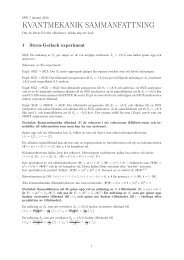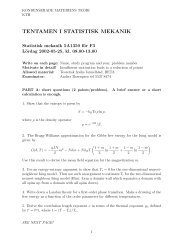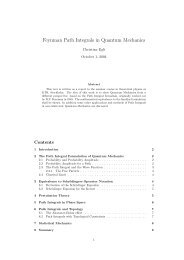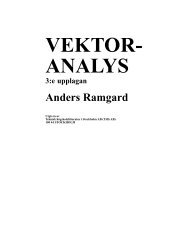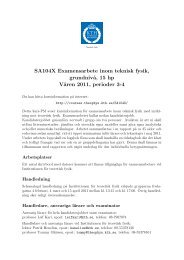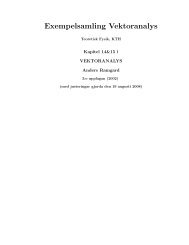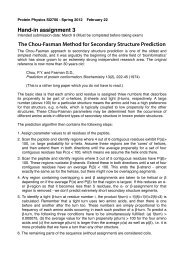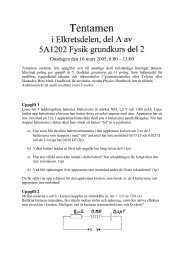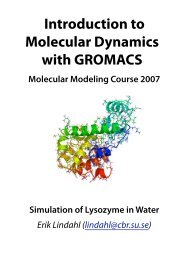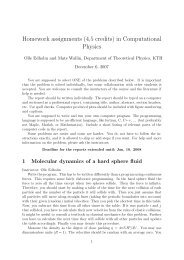[VAR]=Notes on variational calculus
[VAR]=Notes on variational calculus
[VAR]=Notes on variational calculus
Create successful ePaper yourself
Turn your PDF publications into a flip-book with our unique Google optimized e-Paper software.
detail: I hope it will be clear in particular examples, and if not the safe method is<br />
to go back to the computati<strong>on</strong> in (21) and treat the boundary term in more detail).<br />
Anyway, we see that for the expressi<strong>on</strong> in (21) to be zero for every functi<strong>on</strong> η we need<br />
the Euler-Lagrange equati<strong>on</strong>s in (19) to hold true.<br />
In general this is a system of N ODEs of order 2 which are difficult to solve. Let<br />
me menti<strong>on</strong> an<br />
Important example in physics. I. For a mechanical system, the functi<strong>on</strong>al<br />
∫ t1 (<br />
)<br />
S = kinetic energy − potential energy dt<br />
t 0<br />
is called acti<strong>on</strong> of this system, and the Hamilt<strong>on</strong> principle states that the time<br />
evoluti<strong>on</strong> of a system is such that its acti<strong>on</strong> is extremal.<br />
In many important examples the acti<strong>on</strong> is a functi<strong>on</strong>al of the form<br />
S[q] =<br />
∫ t1<br />
t 1<br />
N<br />
∑<br />
j=1<br />
( mj<br />
)<br />
2 q′ j(t) 2 − U(q 1 (t), . . .,q N (t)) dt (23)<br />
where q is a functi<strong>on</strong> <strong>on</strong> [t 0 , t 1 ] with values in R N (e.g. for a system with 2 particles<br />
moving in R 3 we have N = 6, m j = M 1 (mass of particle 1) for j = 1, 2, 3,<br />
m j = M 2 (mass of particle 3) for j = 4, 5, 6, q = (x 1 , y 1 , z 1 , x 2 , y 2 , z 2 ) the collecti<strong>on</strong><br />
of all Cartesian coordinates of the particles, and U the sum of two-body and external<br />
potentials). In this case it is easy to see that Hamilt<strong>on</strong>’s principle implies the usual<br />
Newt<strong>on</strong>’s equati<strong>on</strong>s by Fact D above:<br />
m j q j ′′<br />
t)<br />
(t) = −∂U(q(t),<br />
∂q j (t)<br />
for j = 1, 2, . . ., N (24)<br />
(check that!). One thus can use the acti<strong>on</strong> functi<strong>on</strong>al to define a mechanical system<br />
(rather than Newt<strong>on</strong>’s equati<strong>on</strong>s). This has many advantages...<br />
2.3 Functi<strong>on</strong>als depending <strong>on</strong> functi<strong>on</strong>s of several variable.<br />
Problem 3 above is a special case of the following:<br />
Problem E: C<strong>on</strong>sider the following functi<strong>on</strong>al<br />
∫<br />
J[u] = F(u(x, y), u x (x, y), u y (x, y), x, y)dxdy (25)<br />
Ω<br />
where Ω is some domain in R 2 , and F = F(u, u x , u y , x, y) a C 2 functi<strong>on</strong> in 5 variables.<br />
Find the C 2 functi<strong>on</strong>(s) u <strong>on</strong> Ω which are fixed <strong>on</strong> the boundary ∂Ω of Ω and which<br />
extremize this functi<strong>on</strong>al.<br />
11


![[VAR]=Notes on variational calculus](https://img.yumpu.com/35639168/11/500x640/varnotes-on-variational-calculus.jpg)
